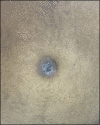Sister Mary Joseph Nodule as an Initial Presentation of Pancreatic Adenocarcinoma
- PMID: 32903972
- PMCID: PMC7447472
- DOI: 10.14309/crj.0000000000000453
Sister Mary Joseph Nodule as an Initial Presentation of Pancreatic Adenocarcinoma
Abstract
Sister Mary Joseph (SMJ) nodule is a metastatic umbilical nodule seen in primary tumors of the gastrointestinal or genitourinary tract. The stomach and colon are the common gastrointestinal cancers associated with SMJ nodule. The pancreas is a rare primary site for umbilical metastasis. Moreover, malignant umbilical nodules as the first presentation in pancreatic cancer is rare. Pancreatic adenocarcinoma that metastasizes to umbilicus usually arise from the body or tail of the pancreas. The presence of SMJ nodule usually indicates poor prognosis. Umbilical nodule is a simple physical finding to the presence of an advanced intra-abdominal malignancy. Although rare, pancreatic cancer should be considered as one of the primary sites in such a situation.
© 2020 The Author(s). Published by Wolters Kluwer Health, Inc. on behalf of The American College of Gastroenterology.
Figures



References
-
- Bolanaki H, Courcoutsakis N, Kouklakis G, Kakolyris S, Karayiannakis AJ. Sister Mary Joseph's nodule as the first sign of pancreatic carcinoma. J Gastrointest Cancer. 2012;43(Suppl 1):S254–7. - PubMed
-
- Shetty MR. Metastatic tumors of the umbilicus: A review 1830-1989. J Surg Oncol. 1990;45(3):212–5. - PubMed
Publication types
LinkOut - more resources
Full Text Sources

